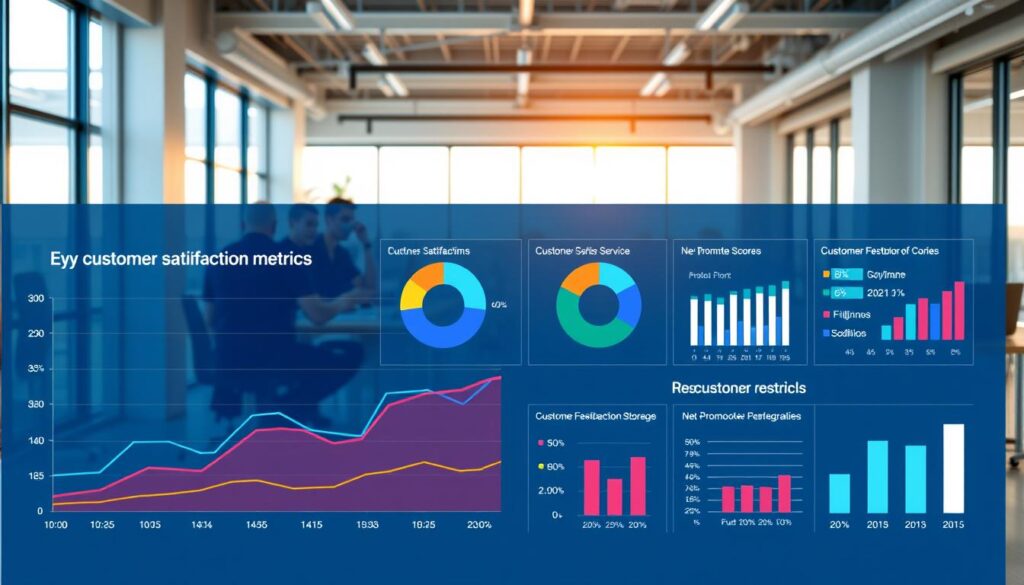Do you know the key metrics that can change how you manage field operations? In Task & Field Force Management, knowing the right metrics is key. It helps boost employee productivity and leads to better results. For small businesses in the Philippines, these metrics are like a guide for growth and improvement.
This article will show you the important metrics to watch. It will also explain how they can help your operations strategy.
Key Takeaways
- Understanding operational metrics is crucial for effective Task & Field Force Management.
- Key performance indicators can significantly enhance employee productivity.
- Focus on metrics that drive financial stability within your organization.
- Monitoring crucial KPIs can lead to improved business performance over time.
- Empowering your team with metrics can facilitate faster decision-making.
- Utilizing real-time data is essential for optimizing field operations.
Understanding the Importance of Operational Metrics
Operational metrics are key to seeing how well a company works and where it can get better. They give insights into things like how many staff members there are, how well employees do their jobs, and the company’s money situation. By looking at these metrics, businesses can make sure they’re on the right track and keep their employees happy.
Operational metrics are more than just numbers. They help with a business performance evaluation. For small and medium enterprises (SMEs) in the Philippines, knowing the KPIs significance can help them make better choices. Using these metrics can show where a business can get better, even in tough markets.
Using operational metrics the right way builds trust and teamwork. It helps set clear goals and standards for everyone. This way, businesses can get their employees to work better and stay ahead in a changing market.
| Operational Metrics | Description | Importance |
|---|---|---|
| Employee Performance | Measures individual contributions and effectiveness | Identifies high performers and areas needing support |
| Financial Health | Assesses profitability and cost management | Guides informed financial decision-making |
| Staffing Levels | Evaluates workforce adequacy | Ensures optimal staffing for service delivery |
| Operational Efficiency | Analyzes process effectiveness | Reveals opportunities for operational improvements |
Key Performance Indicators (KPIs) for Task & Field Force Management
In field operations, using Key Performance Indicators (KPIs) is key. They help check how well an organization does and how it can get better. KPIs show if goals are met and offer insights for making better choices. They are very important for small and medium-sized enterprises (SMEs) to improve their work.
Defining KPIs in Field Operations
Field operations KPIs are like benchmarks. They show things like how well employees work, how good the service is, and how efficient operations are. By looking at certain numbers, companies can make smart choices that help them succeed. Some common KPIs include:
- Customer satisfaction scores
- First-time fix rates
- Service efficiency metrics
These indicators make sure workers are doing their best and giving great service to customers.
Why KPIs Matter for SMEs
For SMEs in the Philippines, using field operations KPIs is very helpful. It helps them use resources wisely and make smart decisions. By understanding these indicators, businesses can spot where they need to get better. This leads to better work and helps them stay strong in the long run.

Monitoring Employee Productivity in Field Operations
In field operations, keeping an eye on how well employees work is key to success. By looking at how well they manage their time and stay focused, businesses can get better at tracking performance. Knowing how much time is spent on work versus distractions helps see how efficient operations are.
Tracking Time Management and Performance
Good time management is vital for boosting employee productivity. Many companies use time-tracking software to see how employees spend their day. This lets managers spot trends and adjust workloads when needed. Tools for tracking performance help keep employees on track and show where they might need more training.
Strategies to Enhance Employee Productivity
To boost employee productivity, a few strategies can help:
- Utilize time-tracking software: This lets employees see how they use their work hours.
- Implement daily checklists: Clear goals help employees stay focused on important tasks, improving time use.
- Offer performance incentives: Rewarding good work boosts morale and keeps productivity high.
These steps not only increase productivity but also help employees grow professionally.
Assessing Quality of Work in Field Operations
Checking the quality of work done by field employees is key to keeping customers happy and the business’s reputation strong. Regular checks help spot areas that need bettering. Getting feedback from customers shows how well services meet their needs and points out what’s working and what’s not.
Measuring Quality through Customer Feedback
Customer feedback is a key tool for judging the quality of field work. Asking for opinions after services are done gives businesses valuable insights. Using surveys and direct talks helps understand what customers think. This way, companies can make sure their services match what customers want, building loyalty and encouraging more business.
Setting up formal ways to collect customer feedback, like those in service quality management essentials, is vital.
Implementing Quality Control Processes
Having strong quality control steps is key to keeping field operations at high standards. Regular checks before and after services are done help ensure they meet the mark. Training staff on quality standards helps them give top-notch service. In the Philippines, focusing on ongoing improvement through quality control can greatly boost how well things run and how happy customers are.

Tracking Absenteeism and Its Impact
Absenteeism tracking is key for keeping productivity high. Each absence can lower workforce efficiency, affecting overall productivity. Finding out why people are absent often shows issues with employee engagement and satisfaction.
In the Philippines, where labor costs are high, missed days mean lost money. Spotting absenteeism patterns lets management tackle disengagement causes. This effort boosts morale and helps keep employees.
Good strategies for boosting engagement include open talks, recognition, and wellness programs. Creating a supportive work place can reduce absences and boost morale. Tracking and solving absenteeism issues can greatly benefit productivity and company culture.
| Year | Absenteeism Rate (%) | Employee Engagement Score | Productivity Impact |
|---|---|---|---|
| 2021 | 8.5 | 70 | 75 |
| 2022 | 7.0 | 75 | 80 |
| 2023 | 5.5 | 80 | 85 |
This table shows how better absenteeism rates and higher engagement scores lead to better productivity. Focusing on absenteeism is crucial for a healthy work environment.
Utilization of Overtime Hours
Managing overtime well can greatly improve how an organization works. It helps keep employees efficient and tasks done, mainly when it’s busy. But, too much overtime can lead to burnout and lower morale. It’s key to find a good balance in workloads for lasting productivity.
Understanding Overtime Costs
Using overtime can have big financial effects. The costs add up fast. Keeping track of these hours helps companies plan their budgets better. Knowing these costs helps make smart choices about staffing and cuts down on waste.
Balancing Workloads Among Employees
It’s important to spread tasks fairly among workers. This boosts their efficiency and cuts down on overtime. Using software to manage the workforce helps adjust schedules as needed. This way, overtime is used when it’s really needed, not all the time.
| Overtime Management Strategies | Expected Benefits |
|---|---|
| Real-time workload analysis | Improved resource allocation |
| Employee feedback on tasks | Increased job satisfaction |
| Flexible scheduling options | Reduced overtime reliance |
| Regular performance reviews | Enhanced employee efficiency |

Financial Metrics: Profitability and Cost Management
Understanding financial metrics is key for any business to succeed today. For small and medium enterprises (SMEs) in the Philippines, looking at gross and net profit is vital. It helps spot where they are doing well and where they need to improve. Good cost management can really boost a company’s bottom line, leading to growth and stability.
Gross Profit vs. Net Profit Explained
Gross profit is what’s left after subtracting the cost of goods sold from revenue. It shows how well the core business is doing. On the other hand, net profit includes all costs, like taxes and interest. It shows the real money left for owners or shareholders.
Knowing the difference between gross and net profit helps businesses make better choices. It guides them on how to use resources and improve efficiency.
The Impact of Operational Expenses on Profitability
Operational expenses can really impact how much profit a business makes. Keeping an eye on these costs is essential for staying financially healthy. High operational costs can cut into both gross and net profit, making things tough financially.
SMEs need to look at their spending and find ways to save money. By focusing on cost management, businesses can boost their profits and do better overall.
Customer Satisfaction Metrics and Their Relevance
In today’s market, knowing customer satisfaction metrics is key for businesses. They help meet client needs effectively. By collecting feedback, organizations can see how well they’re doing and where they can get better.
Collecting Customer Feedback Post-Service
Getting feedback after service is very helpful. Surveys, emails, and calls can get clients’ thoughts right away. This feedback is key to knowing if services are working well and how to make them better.
By focusing on feedback, businesses can see what customers like and what needs work. This helps improve customer experiences.
Analyzing Customer Satisfaction Trends
Keeping an eye on customer satisfaction trends is crucial. It helps businesses stay ahead by adjusting to what clients want. Trends show if satisfaction is going up or down, helping make quick changes.
By watching these trends, businesses can make their services better. This builds stronger relationships with customers and keeps them loyal to the brand.

Key Metrics for Workforce Tracking
Tracking your workforce well is key to better field operations. Real-time data helps managers make fast decisions. This makes operations more efficient and effective.
Utilizing Real-time Data for Decision Making
Real-time data in workforce tracking lets organizations watch field activities closely. Managers get insights into what’s happening now. This helps them decide where to send people and fix problems fast.
Tracking Location-Based Data for Field Workers
Location-based metrics help manage field workers by showing where they are and what they’re doing. GPS helps plan routes better, saving time and improving service. In places like the Philippines, this makes services faster and more reliable.
| Tracking Metrics | Benefits | Application |
|---|---|---|
| Real-time Data | Immediate insights for quick decision-making | Resource allocation, operational adjustments |
| Location-Based Metrics | Efficient route planning and monitoring | Field worker activity tracking, customer service enhancement |
| Employee Productivity | Identifying performance gaps | Boosting output, reducing operational costs |
Identifying Interventions and Success Rates
Measuring how well operational strategies work is key for businesses wanting to get better. Knowing which methods are most effective helps organizations focus on what works best. By looking at success rates, companies can see how often they meet their goals right away.
This shows not just how well they operate but also how happy their customers are.
Tools for tracking performance help small businesses keep an eye on success rates. Using data in real-time, teams can spot trends and make needed changes. When success rates go up, so does customer loyalty. Happy customers mean less need for repeat fixes.
By carefully looking at performance, businesses can make their processes smoother. This saves money and improves the quality of service they offer.
Streamlining Resource Management with Data
Effective resource management is key for any business to improve. Using data optimization helps make better decisions and use assets wisely. An integrated data platform lets companies check each transaction and find where things can be better.
This helps small to medium-sized enterprises (SMEs) quickly adjust to meet their goals. In the Philippines, businesses are seeing the benefits of using data. It helps cut down on waste and improve services.
By focusing on data, companies can stay ahead in a tough market. This focus on resource management is crucial for success.
Implementing Effective Compliance Metrics
Compliance metrics are key to managing safety and keeping operations smooth in field services. Companies need to stay alert to safety rules to avoid risks. Using these metrics helps track and improve policy following at all levels.
Understanding Safety Compliance Requirements
Safety compliance rules protect the workplace. Knowing these rules keeps employees safe and avoids big fines. Companies should check their safety steps often to meet new standards.
Training and audits help make safety a top priority. They show how important following rules is.
Policy Compliance and Its Importance in Operations
Following company policies is crucial for a strong operation. Compliance metrics show how well teams stick to rules. This helps avoid legal problems.
In the Philippines, focusing on policy following makes the workplace safer. It also makes operations more efficient.
Conclusion
In field operations management, tracking key metrics is very important. It helps SMEs in the Philippines a lot. By looking at important performance indicators, companies can improve their services and keep quality high.
Knowing how to use operational metrics is key for making smart decisions. Companies that focus on metrics can use data to make their operations better. This helps them grow and stay ahead of challenges.
For businesses to succeed, they need to use a metrics-driven approach. This means using data to make smart choices. It helps SMEs not just get by, but thrive in a changing market.
FAQ
What are field operations KPIs?
Field operations KPIs are measurable signs that show how well a company is doing. They help track things like how productive employees are, the quality of service, and how efficient things are.
Why are operational metrics important for SMEs in the Philippines?
For SMEs, operational metrics are key. They give insights into how well a business is doing. This helps improve productivity, employee performance, and financial health in a competitive market.
How can productivity be monitored in field operations?
To check productivity, look at how well employees do their tasks. Use tools like time-tracking software and offer incentives to see how well they manage their time. This boosts overall productivity.
What role does customer feedback play in assessing work quality?
Customer feedback is crucial for checking the quality of field work. It shows what’s going well and what needs work. This leads to happier customers.
How can absenteeism impact field operations?
High absenteeism can lower productivity and show problems like employee disengagement. Tracking it helps managers tackle issues early to keep operations smooth.
What should businesses consider regarding overtime hours?
Overtime is okay sometimes, but too much can burn out employees. Keeping an eye on overtime helps manage resources well and keeps workloads balanced.
Why are financial metrics important for SMEs?
Financial metrics, like profit margins, are key for SMEs. They help see how well costs are managed and if the business is profitable. This guides decisions on using resources wisely.
How can customer satisfaction metrics influence business success?
Customer satisfaction metrics show how clients feel about the service. By understanding this, businesses can improve quality, meet customer needs better, and build loyalty. This is crucial for success.
What is the significance of real-time data in workforce tracking?
Real-time data lets managers watch field workers closely. It helps plan routes better and cut down travel time. This boosts productivity and helps adapt to changing needs.
How can success rates be identified in field operations?
Success rates are about how often service requests are done right the first time. Higher rates mean happier customers and more efficient operations.
What does streamlining resource management entail?
Streamlining resource management means using business assets well to improve efficiency. Integrated data platforms help find patterns and areas for better use.
Why is compliance with safety metrics important in field operations?
Safety metrics ensure field work follows rules and keeps everyone safe. This prevents risks and legal problems. It’s key for a safe and smooth work environment.